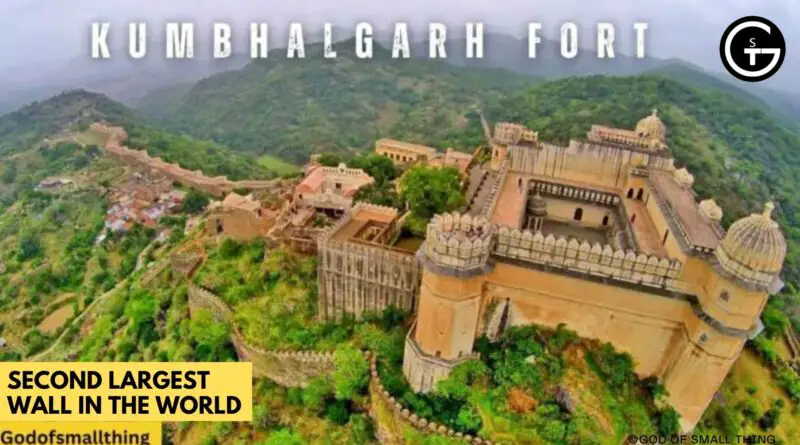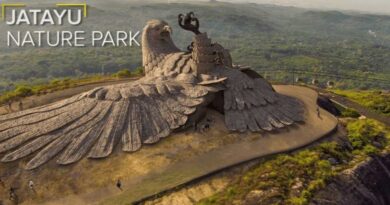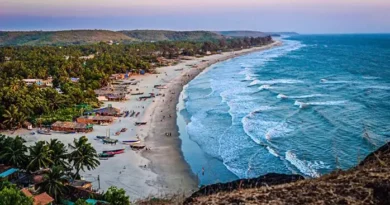Kumbhalgarh Fort 2024: History | Location | When to Visit & more!
Major credit for the “incredibility” of India goes to its rich historical background. Having spent golden years under the reign of many brave kings and respected royals, every place in India has traces from those times. These locations act as guides to introduce us to where we come from, to our heritage, culture, and foundation. In this article, we will talk about a majestic fortress in the state of Rajasthan. One of the most significant of its kind, the Kumbhalgarh fort near Udaipur is a popular tourist destination. The world’s second-longest wall is the fort wall of Kumbhalgarh. Want to know more about this amazing place? Fret not! Today we assume the role of your Kumbhalgarh fort travel guide to tell you every single detail that you’d want to know about the fort. So, here we go, on a ride through the second-largest wall in the world!
Why was the Kumbhalgarh fort built?
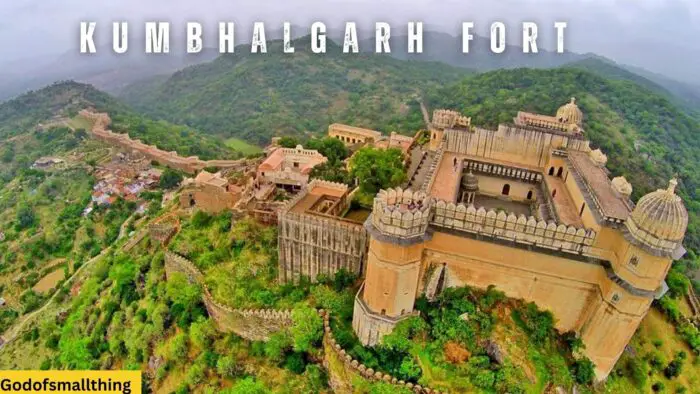
Kumbhalgarh fort, built by Maharana Pratap separates the Mewar and Marwar regions of Rajasthan. This fort with the second largest wall in the world, is one of the few Rajasthan forts that remained unconquered, except in one instance. This was when the drinking water supply of the fort was poisoned, thus causing a major hurdle. The main intention of making this fortress was to provide a safe hub for the Mewar royals in case of an unexpected enemy attack. The location of the fortress was also a perfect point of defence as it is situated amidst the hilly landscape of the Aravalli ranges.
This very purpose was fulfilled in a moment of absolute importance. It was when an infant Udai Singh II, was safely taken to this fort during a brutal attack on Chittorgarh fort. The nurse-maid of the baby Udai Singh, Panna Dhai, is revered even today, for bringing about this secure moving of the prince. She had to sacrifice her own son in this act, who posed as the prince in front of the enemies. For three years, the young prince remained in disguise, under secure boundaries of the Kumbhalgarh fort near Udaypur. Later, his identity was revealed when the situation improved. The same prince grew up to become the Mewar king who established the city of Udaipur. Furthermore, the great Maharana Pratap is the son of the same king, Udai Singh II.
When was Kumbhalgarh for built?
Kumbhalgarh fort history: Kumbhalgarh fort was built in the 15th century, between 1443 AD and 1458 AD, during the reign of Maharana Kumbha. This is how Kumbhalgarh fort gets its name. The chief architect of Kumbhalgarh fort Rajasthan is a famous engineer of the time called Mandan. It is said that earlier a ruined castle stood at the place where Kumbhalgarh fort stands now. This castle is believed to date back to at least 5th century BC. Kumbhalgarh Rajasthan is known for being the birthplace of the brave Maharana Pratap. Additionally, this spectacular fortress is especially popular for housing the Great Wall of India. It is the longest wall in India, which spans about 36 kilometers! It covers 13 mighty hills in the span from its beginning to end! Additionally, it is the second-longest wall in the world and hence, a UNESCO World Heritage Site.
An additional out-of-the-blue fact related to the construction of Kumbhalgarh fort is this: Although Maharana Kumbha initiated the construction, it failed several times and couldn’t be completed. At this point in time, a spiritual person advised the king that a selfless human sacrifice will clear the obstacles. The king was dejected to hear this, as he couldn’t ask anyone to give their life for this purpose. Seeing this, the same spiritual person willingly volunteered to be the sacrifice. Subsequently, Kumbhalgarh fort Rajasthan was built where the head and body fell. It is said that this is at some point near Hanuman Pol inside Kumbhalgarh fort.
Where is Kumbhalgarh fort located?
Kumbhalgarh Fort is a majestic Mewar fortress located in Rajasthan. It is a major tourist attraction in Rajasthan, with the second-largest wall in the world. It comes under the Rajsamand district, near Udaipur. The nearest major cities are Udaipur and Jodhpur at a distance of 85 kilometers and 172 kilometers respectively.
Places to see inside the Kumbhalgarh fort Rajasthan
Kumbhalgarh Fort is a remarkable fort of Rajasthan. The architecture of this Mewar fort is awe-striking. Housing the world’s second-longest wall, which is also the longest wall in India, the Kumbhal fort has several attractions to visit. For one, the fort houses around 360 temples! Nearly 300 out of these are of the Jain pantheon, whereas the remaining are Hindu temples. Apart from these, the fort also has numerous structures like a regal palace, huge, glamorous gateways, royal cenotaphs or Chhatris as they are regionally called, huge wells or Baoris, a small cannon museum, watchtowers, large water reservoirs, gun turrets, beautiful arches and small tunnels among others.
Places to visit inside Kumbhalgarh fort:
- The Enormous Gateways
- Badal Mahal
- Kumbha Palace
- Birthplace of the great Maharana Pratap
- Ganesha temple
- Vedi temple
- Neelkanth Mahadeo temple
- Golerao group of temples
- Bawan Devi temple
- Parsvanatha temple
- Charbhuja temple
- Juna Bhilwara temple
- Pitalia Dev temple
- Mamadeo temple
1. The Enormous Gateways
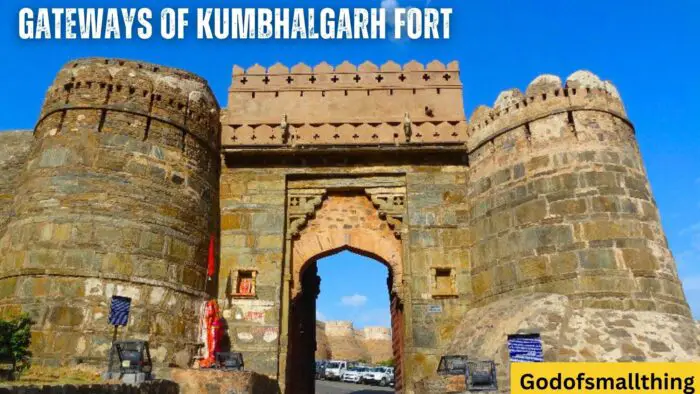
One cannot help but gaze with wonder at the gigantic gates of Kumbhalgarh fort. There are seven gates for entering the fort. Among these, the main entrance for visitors is the Aaret Pol. This gate is on the southern side of Kumbhal fort. The Ram Pol is the most impressive of all the gates, owing to its eye-catching architecture and enormous size. Hanuman Pol is one of the significant gates. There is an image of Lord Hanuman on this gate. It is said that Rana Kumbha bought this image from Mandavpur, especially for establishing this gate. It is also near this gate that the body of the spiritual man who gave his sacrifice, fell on the ground.
The main palatial complex is situated some distance away from the fort entrance. This palatial complex has three gates. These are Paghra Pol, Bhairon Pol, and Nimboo Pol. Apart from these gates, Halla Pol, Vijay Pol, Suraj Pol, Bagga Pol, Choughan Pol, Buraj Pol, and Danibatta are the other gates in Kumbhalgarh fort. Among these, Danibatta is another important gateway. This is because this gateway connects the two significant regions called Mewar and Marwar regions.
2. Badal Mahal
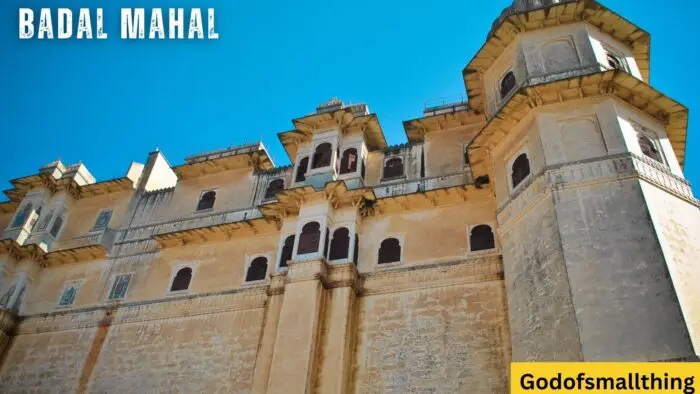
This palace is the most attractive place to visit inside Kumbhalgarh fort. Badal Mahal literally translates to ‘palace of clouds’. You can find such a palace in most palace complexes and forts of Rajasthan. The palace is called so because it is the topmost structure inside the fort. If you look from a distance, the beautiful structure will appear to touch the skies! No doubt, you will have to climb through a steep flight of stairs to reach the palace. But the climb is totally worth it because of two reasons: the interiors of the palace are exceptionally beautiful, and it provides the best view of the Aravalli ranges from this point.
This palace was built by Rana Fateh Singh. The interior of the palace is separated into two sections: the Mardana Mahal and the Zenana Mahal. While the Mardana Mahal was accessed by the men of the royal family, the Zenana Mahal was occupied by royal women. One exceptional feature of the Zenana Mahal is the small jalis or windows made of sandstone. It is through these windows that the royal women used to watch the proceedings taking place outside. Additionally, the central courtyard in this palace is large and spacious and offers a great location for some amazing clicks. Moreover, if you’re in Kumbhalgarh fort, try and experience the sunset from Badal Mahal. Rightly the abode of the clouds, this is the best sunset viewpoint from inside the fort.
3. Kumbha Palace

Unlike the Badal Mahal, Kumbha Palace is located on a lower height. This was the residence of Rana Kumbha, the Rajput King who built Kumbhalgarh fort. The palace is situated in the proximity of Paghra Pol. Kumbha Palace was built during the fort construction, and hence, is much older than Badal Mahal. The palace houses numerous halls including a remarkable durbar hall, a temple dedicated to Goddess Nava Durga, and many smaller rooms. The structure of this palace is two-storeyed. The Jharokhas or enclosed balcony structures in the halls of Kumbha Palace are an example of fine architecture.
4. Birthplace of the great Maharana Pratap
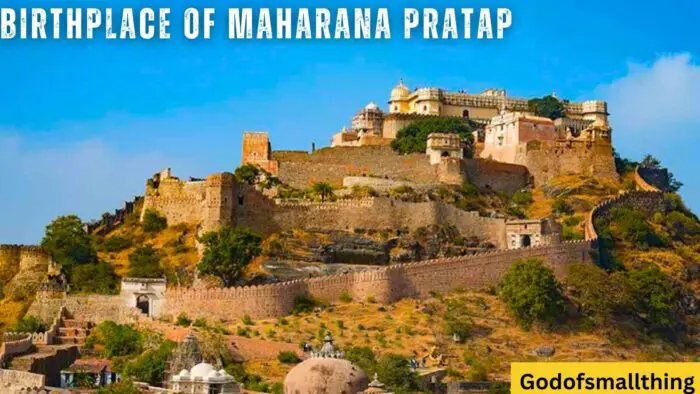
One of the major reasons why the Kumbhalgarh fort is famous and attracts a lot of tourists is because of its historical significance. The great, brave Rajput King Maharana Pratap was born in Kumbhalgarh fort. Maharana Pratap was the son of Udai Singh II, who founded the Udaipur City. The palace inside Kumbhal fort which is the birthplace of Maharana Pratap is called Jhalia ka Malia, or the palace of Queen Jhali. This palace is situated near Paghra Pol and it has a rather simple appearance compared to the other two palaces. The walls are plain and a flat roof safeguards the interiors. The palace is made of rubble stone and if you look carefully, you can find traces of paintings made many centuries back on the walls of this palace.
5. Ganesha temple
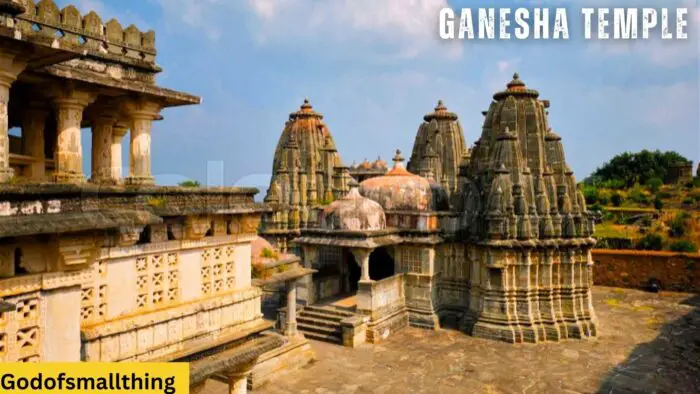
After entering through Ram Pol, you can find a stunning temple towards the west. This is the Ganesha temple in Kumbhalgarh fort Rajasthan. As the name suggests, the main shrine of the temple is of Lord Ganesha. This temple was built by Rana Kumbha. An inscription in Chittaurgarh fort, on the Kirttistambha, says that Maharana Kumbha used to pray to an image of Ganesha inside this temple. The temple has a sanctum sanctorum, a Mantapa, a Mukhya Mantapa, and an Antarala. This is one of the many temples to visit inside Kumbhalgarh fort.
6. Vedi temple

The Vedi temple is famous as the location where the Yagya or rituals after completing the Kumbhalgarh fort construction was done. Built-in 1457 AD, this is one of the many temples established by Rana Kumbha inside the fort. If you enter through Ram Pol, you can locate the Vedi temple complex to the right. The temple structure is two-storeyed and octagonal in shape. It is constructed on an elevated platform such that it faces the west direction. As you explore this temple, you can find the Yagya Vedi where the Yagya was conducted. Along with this, there is also a square-shaped Chhatri or cenotaph and a smaller temple having a triple shrine of Goddesses. There are about 36 pillars inside this temple and the architecture of these structures is marvelous.
7. Neelkanth Mahadeo temple
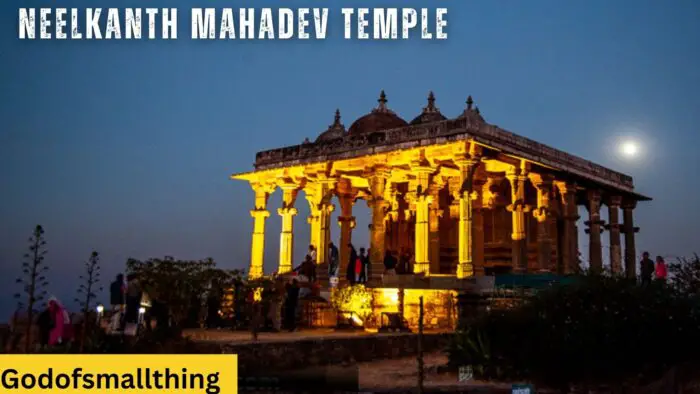
After you visit the Vedi temple, you can easily locate the Neelkanth Mahadev temple which is situated behind Vedi temple, towards the right side. This temple was again built by Rana Kumbha, in 1458 AD. This temple houses a gigantic Shivling. It is said that this is the largest Shivling in the world. While entering the temple, you will find a statue of Nandi, the bull vehicle of Shiva, like in most Shiva temples. The main shrine is accessible through all four directions.
The temple is built on an elevated platform and you can reach to the top via the broad steps. Some of the distinctive features of this temple include the seven-domed roof and the massive pillars. There are 26 pillars inside this temple. Amongst these, one pillar has an inscription which states that the temple was renovated during the time of Rana Sanga, who was the grandfather of Maharana Pratap.
8. Golerao group of temples
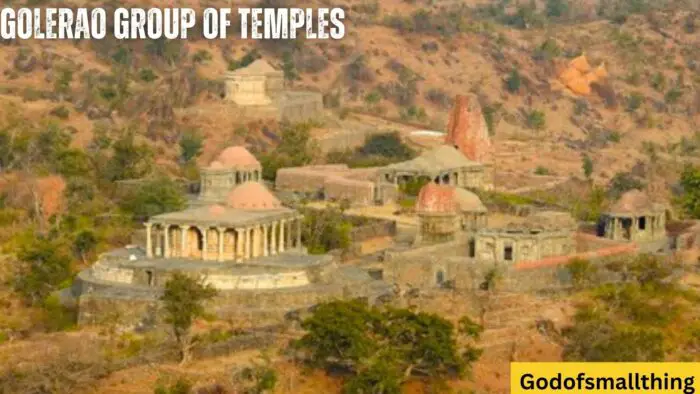
A unique sight at the center of the fort complex, there are nine temples in a group. This group of temples is called the Golerao group of temples. All these nine temples are enclosed inside a circular wall. Out of the nine temples, four temples are of Jain pantheon, while the remaining five are Hindu temples. Unfortunately, only some of these temples are in good condition. Although the rest are in ruins, the Golerao group of temples are of great historical significance. These temples are believed to have been built during the reign of Maharana Kumbha. There is an inscription in one of the temples which states that the temple was built in 1459 AD. Some temples in this group are even older than that. Inside the temples that are in good condition, you can find spectacular sculptures and carvings of various Gods and Goddesses.
9. Bawan Devi temple

Bawan means fifty-two. This Jain temple complex has fifty-two miniature shrines. These are called Devakulikas. Among these shrines, fifty are of the same size and structure. The remaining two are comparatively bigger and are the main shrines. The main shrine houses a specific setup with the sanctum sanctorum, Antarala, and an open Mantapa. Additionally, there is an image of Jaina Tirthankara inside the main shrine. The inscriptions inside the temple indicate that the temple dates back to the 15th century, and was built in 1464 AD. This group of 52 temples is a distinctive sight of Kumbhalgarh fort.
10. Parsvanatha temple
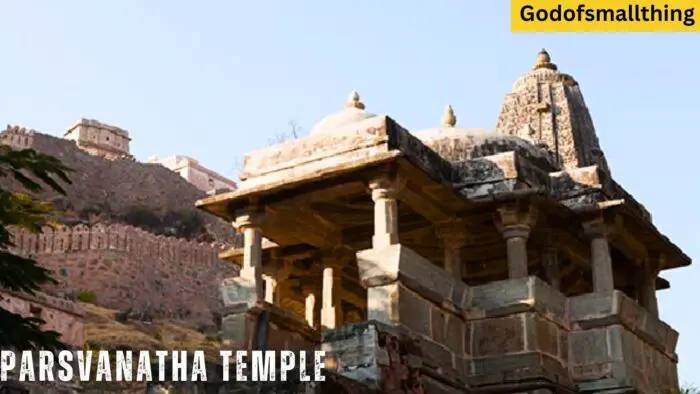
This temple is dedicated to the Jaina Tirthankara Parsvanatha. This was built in the year 1451 AD, by Nar Singh Pokhad. There is a large idol of Jaina Tirthankara Parsvanatha inside the temple. This temple is located on the left side of the Neelkanth Mahadeo temple.
11. Charbhuja temple
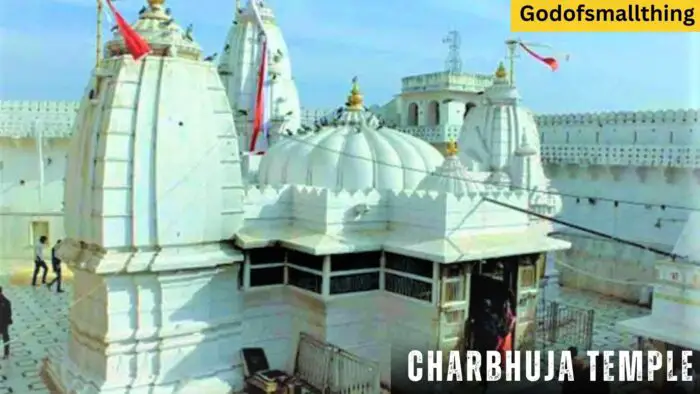
You will find another majestic temple while proceeding towards the palatial complex. This is the Charbhuja temple. Charbhuja literally means ‘four arms’. This temple has the main shrine of Goddess with four arms. Hence the name. It is one of the many beautiful temples inside the fort complex.
12. Juna Bhilwara temple
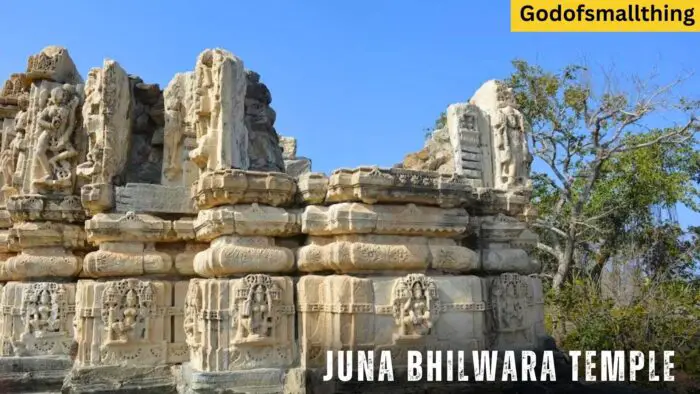
This is a Jain temple inside the Kumbhalgarh fort complex. The temple has a sanctum sanctorum with more than one deity and a shrine of four-armed Tirthankara. Apart from this, there is an Antarala and a Mantapa in the temple. Most of the parts of this temple are ruined. However, it is a great deal for exploration.
13. Pitalia Dev temple
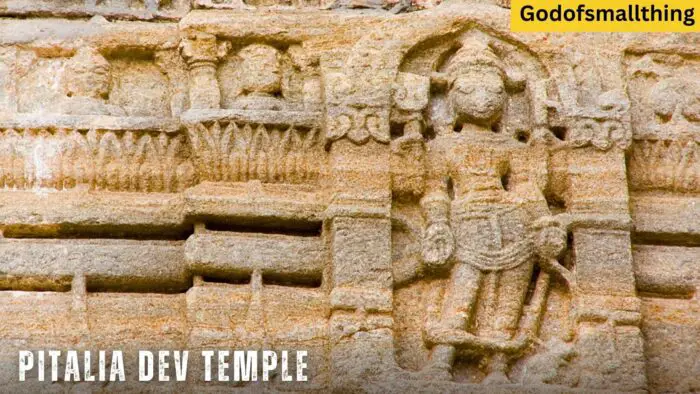
This temple is another Jain temple in Kumbhal fort. The name is derived from the fact that it was built by Pitalia Jain Seth. Constructed in 1455 AD, Pitalia Dev temple stands on a raised platform. The temple houses a sanctum sanctorum, and a distinguished Sabhamantapa. Though the temple faces east, the main shrine can be accessed through all four directions. There are eye-catching images of Gods, Goddesses, and other mythological characters inside this temple.
In case you want to know about the best temples in India, here is a travel guide that can prove to be handy for you – Complete Travel Guide to Famous and Best Temples in India
14. Mamadeo temple
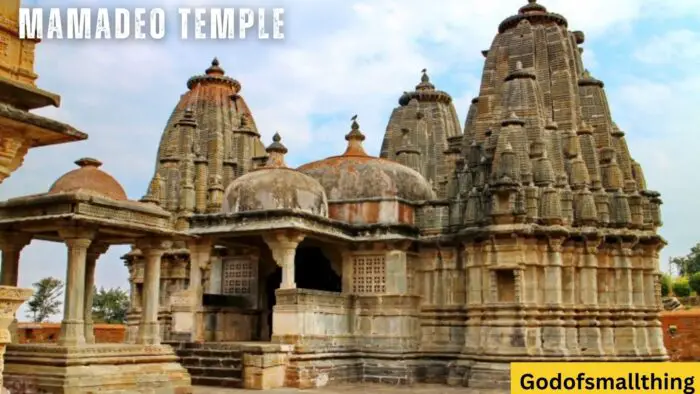
This temple is also known as the Kumbha Shyam. The temple has a distinctive inscription of Rana Kumbha giving a thorough history of Kumbhalgarh Rajasthan. The sanctum sanctorum of the temple has a flat roof. Additionally, there is a pillared Mantapa inside the temple.
Apart from these attractions, you can explore the following points inside Kumbhalgarh fort for a complete experience:
Lakhola Tank, Toop Khana, Kheda Devi temple, Prithviraj ki Chhatri, Rani Chura ki Bari, Harbara ki Bari, Suraj Devris temple, Tedda Bari cave, Dudh Talai ki Bari, Sandh ka gate, Riya ki baori and shrine, Sankhila Nahar ki Bari, and Pritilya Shah Jain temple among others.
How to reach Kumbhalgarh fort?
Kumbhalgarh fort is at a distance of 84 kilometers from Udaipur, one of the main cities of Rajasthan. When traveling by road, it will take nearly two to two and a half hours to reach Kumbhalgarh Rajasthan from Udaipur. Additionally, there are state transport buses to take you to Kumbhalgarh. If you travel by air, you can alight at Udaipur airport, the nearest airport from the fort. The airport is 100 kilometers away from Kumbhal fort. On the other hand, if you are traveling by train, the nearest railway station is Falna station. This railway station is about 67 kilometers from the fort.
Kumbhalgarh fort location
Kumbhalgarh fort near Udaipur stands with its head held high, in the backdrop of the mighty Aravallis. It is located in the Rajsamand district of the Rajasthan state in India. Tourists from all across the world come here to witness the world’s second longest wall. About 85 kilometres from the famous Rajasthan city of Udaipur, Kumbhalgarh is accessible in about 2 hours from Udaipur. This location of the fort, Kumbhalgarh Rajasthan, separates two major regions in Rajasthan called Mewar and Marwar from each other. It is also accredited as the second most significant fortress of Mewar, the first being Chittorgarh fort. The exact location of Kumbhal fort is as follows:
Kumbhalgarh fort, Kumbhalgarh, Rajasthan 313325
What are the timings for Kumbhalgarh Fort?
Kumbhalgarh Fort is open to visitors and tourists on all days of the year. The fort opens at 9 in the morning until 6 in the evening. The light and sound show takes place in the evening at 6.45 pm. This show is one of a kind, which takes one through a ride of the history of the fort. The duration of the show is 45 minutes. It is one of the many experiences to enjoy at Kumbhal Fort.
What is the entry fee for Kumbhalgarh Fort?
The entry fee for Kumbhalgarh Fort is as follows:
Indian National: 15 INR per head
Foreign National: 200 INR per head
For sound and lights show:
Adults: 100 INR per head
Children: 50 INR per head
When is the best time to visit Kumbhalgarh Fort?
Kumbhalgarh fort Rajasthan is open on all days throughout the year. However, since the summers in Rajasthan are quite hot, it is best to visit the place during monsoon and winter. This is because a thorough exploration of Kumbhal fort will take you at the most half a day. After all, it is enclosed inside the second largest wall in the world, which is 36 kilometers long. So, you might easily wear out in the scorching heat of the summers. Hence, the most recommended time to visit Kumbhalgarh Rajasthan is between September and March.
The Kumbhalgarh festival is a famous annual festivity held at the fort. It is organized by the Department of Tourism of Rajasthan. The festival lasts for 3 days and is celebrated with the purpose of promoting the cultural, artistic, and historical significance of Kumbhalgarh Rajasthan. It is usually conducted during the winter. This is one of the best opportunities to relish the rich heritage of Rajasthan. This is also one of the most elite time to visit the grand Kumbhalgarh fortress.
What is the distance from Udaipur to Kumbhalgarh?
The city of Udaipur is 85 kilometers away from Kumbhalgarh Rajasthan. If you are traveling by air, you can alight at Udaipur airport, which is the nearest airport to Kumbhalgarh. This airport is nearly 100 kilometers from Kumbhal fort. So, you will have to hire a taxi or catch a bus to reach Kumbhalgarh from Udaipur. It will take you about 2 hours to reach the fort from Udaipur city. On the other hand, the Udaipur railway station is 85 kilometers from the fort. You can also access state transport buses plying from Udaipur city to reach Kumbhalgarh fort.
What are the places to visit near Kumbhalgarh fort?
- Kumbhalgarh wildlife sanctuary
- Ranakpur Jain temple
- Haldi Ghati
- Sahastra Bahu temples
- Ekling ji temple
- Udaipur City
1. Kumbhalgarh Wildlife Sanctuary

If there is anything as fantastic as the fort in Kumbhalgarh, it is the dense forest and hills that surround it. The Kumbhalgarh wildlife sanctuary is called so as it covers a major portion around the fort. During the olden times, this location was a hunting ground for the royal family. Spanning across an impressive 610 square-kilometers, it is one of the richest forests of Rajasthan. Nearly four mountains of the Aravallis come under the sanctuary. Additionally, there are twenty-two villages within the boundaries of the sanctuary. The sanctuary boasts of rich faunal diversity. It accommodates some of the best wildlife species in India. Panthers, pythons, jackals, hyenas, and deer can be sighted here. Apart from these, the sanctuary is also home to Asiatic lions, wolves, sambhars, sloth bears, jungle cats, and leopards. Several rare and endangered animal species find refuge in these forests.
Followed by a rich bird population, you can also spot species like white-breasted kingfishers, spur owls, golden orioles, bulbuls, peacocks, and parakeets in the sanctuary. More than 200 species of birds are found in Kumbhalgarh sanctuary. Tourists who visit the fort plan on a combined visit to the sanctuary as well. There are safaris organized inside the sanctuary, like jeep safari, foot trekking, and horse safari.
The jeep safari covers a distance of about 15 kilometers. The duration of this safari ranges between 3 to 4 hours. Tickets are available for the safari of the Kumbhalgarh Wildlife Sanctuary at the entrance of Kumbhalgarh Fort. The Safari rate is 2500 INR per jeep, which can accommodate six adults. All in all, the Kumbhalgarh Wildlife Sanctuary is an ideal location for nature lovers, adventurers, and wildlife enthusiasts. You may spare an entire day for a combined visit of both the fort and the sanctuary.
2. Ranakpur Jain temple
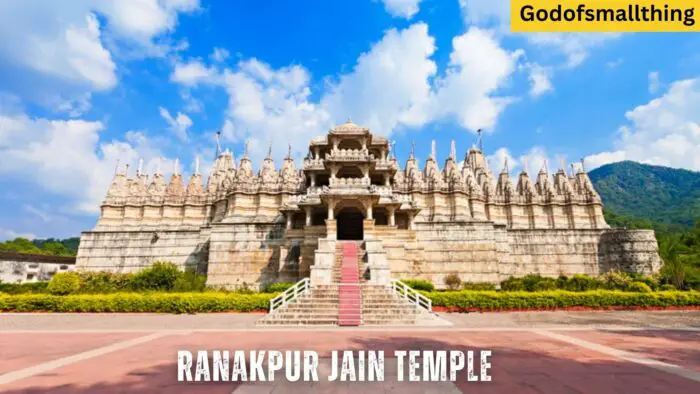
One of the major Jain temples in India, Ranakpur Jain Temple is situated about 33 kilometers from Kumbhalgarh Fort. This temple is dedicated to the Jain Tirthankara Rishabhanatha. Also called Chaturmukha Dharana Vihara, the temple was built in the first half of the 15th century. Records state that it took nearly 50 years to complete the temple construction. The temple was built by Darna Shah who was a Jain businessman.
Apparently, Darna Shah once had a dream of a celestial vehicle. Inspired by this, he decided to construct a temple of the same shape. Hence, the Ranakpur temple is of the shape of the celestial vehicle called Nalini-Gulma Vimana. Dwepa was the chief architect of the temple. The temple was constructed during the reign of Rana Kumbha. The King offered support and help towards the temple construction. This is why the temple and the surrounding region is known as Ranakpur.
The architecture of the temple deserves high applause, for its intricacy and fine detailing. The architectural style employed in this temple is of the Maru-Gurjara style. This style of architecture was prominent in North India during the 11th to 13th centuries. This is one of the largest Jain temples in the world. There are several temples inside the temple complex like Suparshvanatha Temple, Chaumukha Temple, Amba Temple, Sethi ki Badi Temple, and Surya Temple. The main shrine is dedicated to the first Jain Tirthankara named Adinatha. The temple is one of the main locations that form the Gorwad Panch Tirth. Ranakpur Jain temple attracts plenty of visitors because of its religious and historical significance. However, the highlight of the temple is indeed the spell-binding architecture. We suggest that you check out this amazing destination on your tour of Kumbhalgarh fort Rajasthan.
Since you are reading about Temples, and when we talk about Temples, you just cannot miss Vrindavan! Here is a Complete Travel Guide to Famous and Best Temples in Vrindavan and Mathura
3. Haldi Ghati

We talked in detail about the birthplace of Maharana Pratap in Kumbhalgarh Fort. Now, we will talk about one of the most valiant battles fought in Indian history. Around 49 kilometers from Kumbhalgarh fort, the battle of Haldi Ghati was fought on 18th June 1576. The Mewar front was led by Maharana Pratap, against the Mughal army under Emperor Akbar. This place is today a mountain pass called the Haldi Ghati Pass. One of the significant points to visit here is the cenotaph of Chetak, the horse of Maharana Pratap who was also his brave companion. Chetak suffered fatal injuries in the Battle of Haldighati and died three days later. This cenotaph known as Chetak Smarak was erected by Maharana Pratap himself, in memory of Chetak. The Department of Tourism later built the Maharana Pratap National Memorial here, to commemorate the valor of the brave king.
Apart from its historical significance, Haldi Ghati also has geological significance. The soil of this mountain range is turmeric yellow in color. This is why this place is called Haldi Ghati: Haldi means turmeric and Ghati means mountain pass. The mountain pass is situated on the Aravalli ranges and connects two districts of Rajasthan: Pali and Rajsamand. Haldi Ghati is also famous for the mud art of Molela. This terracotta art is exclusive to the region and is globally famous for its uniqueness. Furthermore, Haldi Ghati is known for its charity rose products. Since it is located near Kumbhalgarh Fort as also shares the timeline and history of the fort, visiting Haldi Ghati along with Kumbhal Fort gives you a better idea of the events.
4. Sahastra Bahu Temples
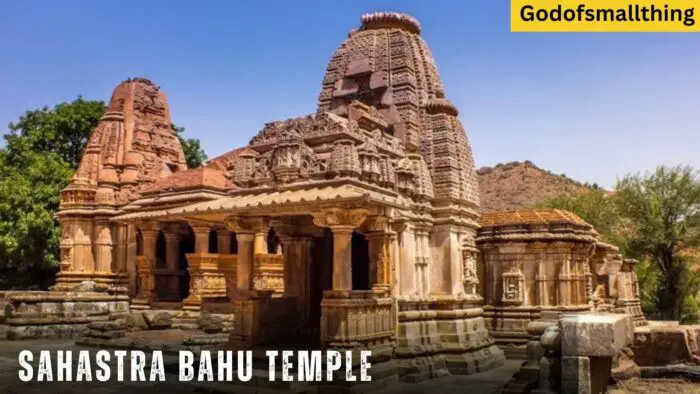
Another gem of architectural brilliance, the Sahastra Bahu temples are a pair of temples that date back to the 10th century. The location of this temple complex is about 70 kilometers from Kumbhalgarh fort. It is situated in a village called Nagda in the Udaipur district of Rajasthan. The temples are dedicated to Vishnu. The form worshipped here is the thousand-armed form of Vishnu. This is why the temple is called Sahastra Bahu temple; Sahastra means thousand and Bahu means arms. The temple is accredited for its marvelous architecture. One of the temples is slightly smaller than the other. Both the temples have a common platform and a temple tank. There are ten shrines in the bigger temple among the two, while four shrines are present in the smaller temple. The Sahastra Bahu temples are on the list of heritage monuments of the Archeological Survey of India.
5. Ekling ji Temple

Ekling Ji temple is a Shiva temple in the Udaipur district of Rajasthan. The deity of Ekling ji temple was the principal ruling deity of the Maharanas of Mewar. The temple is situated near Sahastra Bahu temple. It is at a distance of 71 kilometers from Kumbhalgarh Rajasthan. This 8th-century temple was originally built by Bappa Rawal, a King of the Guhila clan of the Sisodia dynasty. However, the temple suffered severe destruction during the rule of the Delhi Sultanate. Major parts of the temple and the main idol were destroyed. Rana Hammir who was the Mewar King during the 14th century reinstalled the idol.
Subsequently in the following century, Rana Kumbha rebuilt and renovated the temple. There is an inscription on the temple that states that Rana Kumbha is the personal servant of Ekling. This inscription dates back to 1460 AD. However, the temple suffered another demolition episode by the Malwa Sultanate in the late 15th century. Rana Raimal, son of Rana Kumbha later restored the temple in its current form.
6. Udaipur City
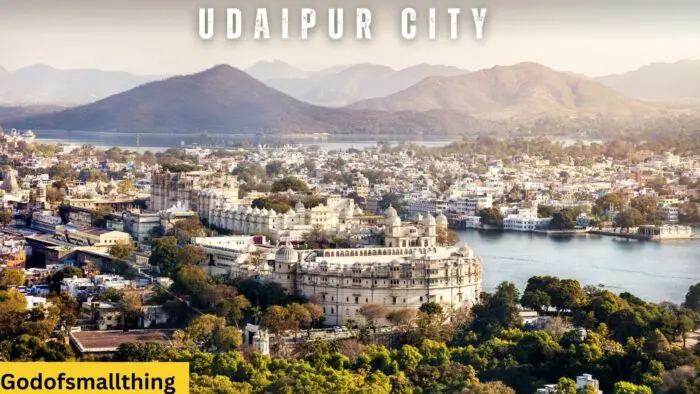
One of the major cities of Rajasthan, Udaipur was founded by Udai Singh II, the father of the brave Maharana Pratap in 1558. The city, popular as the ‘the city of lakes’ is one of the top tourist destinations to visit not only in Rajasthan but in India. The rich cultural heritage and gorgeous locations add to the grandeur of Udaipur. If the palaces from the Rajput reign are a marvel, the splendor of the Aravallis is no less. During British rule, a British administrator named James Tod once rightly described Udaipur as ‘the most romantic spot on the continent of India’.
There are seven lakes that surround the city of Udaipur. This is why is called the city of Lakes. The major tourist spots in Udaipur include the City Palace, Lake Palace, Jag Mandir, Monsoon Palace, Lake Pichola, Jagdish Temple, Kesariyaji Temple, Saheliyon ki Bari, Moti Magri, and Fateh Sagar Lake. Udaipur is a major city that is nearest to the Kumbhalgarh fort. It is at a distance of 84 kilometers from the fort. No matter you choose to travel to Kumbhalgarh Rajasthan by air or train, it connects through Udaipur. Hence, it is a great idea to spend a memorable holiday at Udaipur while on a trip to Kumbhalgarh Fort.
What are things to keep in mind before visiting Kumbhalgarh Fort?
Kumbhalgarh fort is one of the largest and most significant forts of Rajasthan. This Mewar fort wall is the second largest wall in the world. So, it goes without saying that a thorough exploration of the fort will cost you a few hours. Carry water with you on the trip. Apart from that, keep some snacks handy as there are only a few eateries around the fort area. Wear comfortable clothing, if possible, cotton clothing, as the weather is hot and humid most of the time. Wearing sunscreen is highly recommended. It is also a great idea to have some protective gear like hats or umbrellas for protection against the scorching sun. Put on comfortable walking shoes that are in good condition. You have to do a lot of walking inside the fort. There are no guides available inside the fort. The signboards will help you locate places though.
Final words…
Kumbhalgarh Fort is a true gem among historical monuments and buildings of India. The massive size and well-planned structure is a reflection of the brilliance and advanced planning of the rulers of 15th-century India. The entire world knows that the Great Wall of China is the longest wall in the world. However, not many of us know that the world’s second-longest wall is in India. Kumbhalgarh Fort is a masterpiece of Indian architecture. The world will know of our monuments and culture, only when we will first know about them. That being said, do not forget to check out this marvelous fort on your next Rajasthan trip.
Trending at Godofsmallthing Travel – Visit India’s cleanest city – Chandigarh

